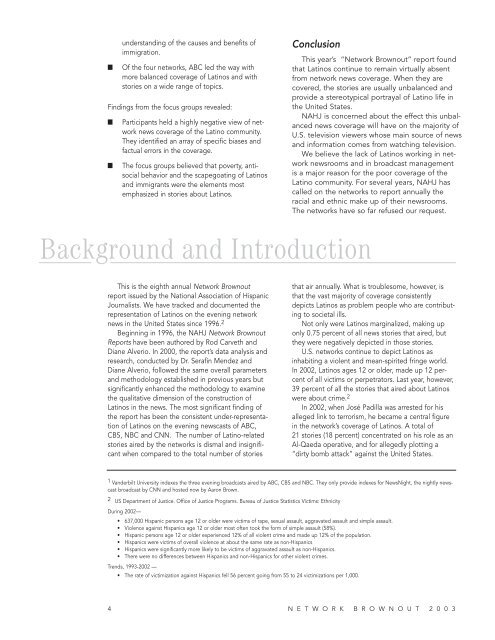You also want an ePaper? Increase the reach of your titles
YUMPU automatically turns print PDFs into web optimized ePapers that Google loves.
understanding of the causes and benefits of<br />
immigration.<br />
■ Of the four networks, ABC led the way with<br />
more balanced coverage of Latinos and with<br />
stories on a wide range of topics.<br />
Findings from the focus groups revealed:<br />
■ Participants held a highly negative view of network<br />
news coverage of the Latino community.<br />
They identified an array of specific biases and<br />
factual errors in the coverage.<br />
■ The focus groups believed that poverty, antisocial<br />
behavior and the scapegoating of Latinos<br />
and immigrants were the elements most<br />
emphasized in stories about Latinos.<br />
Background and Introduction<br />
This is the eighth annual <strong>Network</strong> <strong>Brownout</strong><br />
report issued by the National Association of Hispanic<br />
Journalists. We have tracked and documented the<br />
representation of Latinos on the evening network<br />
news in the United States since 1996. 2<br />
Beginning in 1996, the <strong>NAHJ</strong> <strong>Network</strong> <strong>Brownout</strong><br />
<strong>Report</strong>s have been authored by Rod Carveth and<br />
Diane Alverio. In 2000, the report’s data analysis and<br />
research, conducted by Dr. Serafín Mendez and<br />
Diane Alverio, followed the same overall parameters<br />
and methodology established in previous years but<br />
significantly enhanced the methodology to examine<br />
the qualitative dimension of the construction of<br />
Latinos in the news. The most significant finding of<br />
the report has been the consistent under-representation<br />
of Latinos on the evening newscasts of ABC,<br />
CBS, NBC and CNN. The number of Latino-related<br />
stories aired by the networks is dismal and insignificant<br />
when compared to the total number of stories<br />
Conclusion<br />
This year’s “<strong>Network</strong> <strong>Brownout</strong>” report found<br />
that Latinos continue to remain virtually absent<br />
from network news coverage. When they are<br />
covered, the stories are usually unbalanced and<br />
provide a stereotypical portrayal of Latino life in<br />
the United States.<br />
<strong>NAHJ</strong> is concerned about the effect this unbalanced<br />
news coverage will have on the majority of<br />
U.S. television viewers whose main source of news<br />
and information comes from watching television.<br />
We believe the lack of Latinos working in network<br />
newsrooms and in broadcast management<br />
is a major reason for the poor coverage of the<br />
Latino community. For several years, <strong>NAHJ</strong> has<br />
called on the networks to report annually the<br />
racial and ethnic make up of their newsrooms.<br />
The networks have so far refused our request.<br />
that air annually. What is troublesome, however, is<br />
that the vast majority of coverage consistently<br />
depicts Latinos as problem people who are contributing<br />
to societal ills.<br />
Not only were Latinos marginalized, making up<br />
only 0.75 percent of all news stories that aired, but<br />
they were negatively depicted in those stories.<br />
U.S. networks continue to depict Latinos as<br />
inhabiting a violent and mean-spirited fringe world.<br />
In 2002, Latinos ages 12 or older, made up 12 percent<br />
of all victims or perpetrators. Last year, however,<br />
39 percent of all the stories that aired about Latinos<br />
were about crime. 2<br />
In 2002, when José Padilla was arrested for his<br />
alleged link to terrorism, he became a central figure<br />
in the network’s coverage of Latinos. A total of<br />
21 stories (18 percent) concentrated on his role as an<br />
Al-Qaeda operative, and for allegedly plotting a<br />
“dirty bomb attack” against the United States.<br />
1 Vanderbilt University indexes the three evening broadcasts aired by ABC, CBS and NBC. They only provide indexes for NewsNight, the nightly newscast<br />
broadcast by CNN and hosted now by Aaron Brown.<br />
2 US Department of Justice. Office of Justice Programs. Bureau of Justice Statistics Victims: Ethnicity<br />
During 2002—<br />
• 637,000 Hispanic persons age 12 or older were victims of rape, sexual assault, aggravated assault and simple assault.<br />
• Violence against Hispanics age 12 or older most often took the form of simple assault (58%).<br />
• Hispanic persons age 12 or older experienced 12% of all violent crime and made up 12% of the population.<br />
• Hispanics were victims of overall violence at about the same rate as non-Hispanics<br />
• Hispanics were significantly more likely to be victims of aggravated assault as non-Hispanics.<br />
• There were no differences between Hispanics and non-Hispanics for other violent crimes.<br />
Trends, 1993-2002 —<br />
• The rate of victimization against Hispanics fell 56 percent going from 55 to 24 victimizations per 1,000.<br />
4 N E T W O R K B R O W N O U T 2 0 0 3



